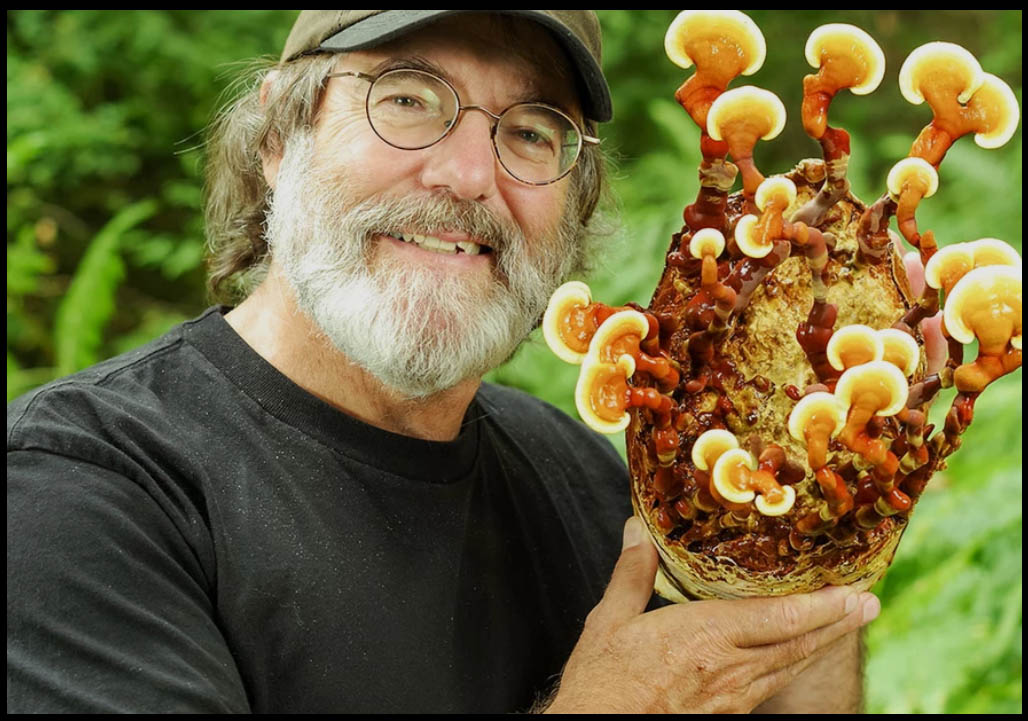
- support the immune system.
- represent a pesticide-free alternative to the traditional white button mushroom.
- are instrumental in the recycling of wood and agricultural byproducts.
- can easily be grown by everyone—outdoors in your garden or yard (Mycological Landscaping)—or indoors within greenhouses, solaria, or controlled environments.

Celebrate Decomposition!
Humans are experts in their misguided attempts to clean up the environment. Such is the case with our misunderstanding of the importance of decomposition. I wish to help reframe the benefits of fungi with a “Let it Rot” campaign. Rather than removing or chipping a fallen tree, or branches, leave them on your property and allow them to decompose to support fungal biodiversity. Alternatively, inoculate the fallen wood with gourmet mushrooms (see more about this subject here) and see how new delicacies can bloom with a little help from nature’s recyclers.
While sinister actors like root rot, rust mold, and blight make the news headlines, the truth is that fungi form an essential underpinning of the natural world. Carbon cycling; soil formation; nutrient mineralization and utilization; protection from pathogens and herbivores; and control of plant and insect populations are only a few of the roles that fungi fulfill in the environment.
The saprophytic or wood-decomposing fungi help drive the global carbon cycle by making the carbon stored in wood available to build soils, microbial communities, and ultimately nourish plants. The “white rot” fungi (such as Oyster mushrooms) break down the lignin in wood and the “brown rot” fungi (such as Chicken of the Woods) break down the cellulose. As these fungi dine, their extracellular digestive systems leak some of the nutrients into their surrounding environment. These liberated nutrients that escape digestion by the fungi become “mineralized” in the soil and help form the base of the terrestrial food web.
The mycorrhizal species—including some favorite edible mushrooms like Chanterelles and Porcini mushrooms—critically aid the growth of their plant symbionts by scavenging and translocating mineral nutrients such as phosphate. Throughout the process they colonize the roots of the plants and alter the microbial community in the rhizosphere (root zone) to help protect their plant host from pathogens. Acids and digestive enzymes secreted by mycorrhizal fungi (as well as saprophytic species and lichens) can even break down rocks to further liberate minerals and micronutrients. The increased growth of the plant improves crop yields, soil aggregation, and carbon immobilization, to name just a few of the benefits.
Endophytic fungi are a fascinating group that live within and between the vascular cells of plants in a mutualistic relationship. Researchers are now discovering them within nearly every plant that has been studied. These hidden fungi are known to increase drought tolerance and reduce predation by herbivores, among other yet-to-be discovered benefits to their host plants.
So, the take-home message here is: Let It Rot! While there are certainly legitimate concerns about the rise of fungal pathogens, cankers, and blights amidst a warming planet, there is no reason to let them blind us to the wonders of the fungal fabric that builds and binds our biosphere. Explore, study, and cultivate the fungi in your life and see nature rebound in a joyous chorus with fungi leading the way!
To our planet,

Helping the Ecosystem through Mushroom Cultivation
Adapted from the article, “Earth’s Natural Internet” by Paul Stamets,
published in the Fall 1999 issue of Whole Earth Magazine
Mushroom growing isn’t just a rapidly expanding agribusiness; it’s also a significant tool for the restoration, replenishment and remediation of Earth’s overburdened ecosphere. Like most people, we at Fungi Perfecti are concerned about the depletion of resources, loss of habitat and release of toxic substances into the environment. We’d like to show you some of the many ways in which the cultivation of mushrooms can help to tip the scales in Nature’s favor, thereby benefiting all the inhabitants of Planet Earth.
Farmers, gardeners and scientists have long known about the importance of healthy soil. Human populations have ebbed and flowed according to the carrying capacities of their environment and the food chain it provides. But despite our long history with our environment, we know surprisingly little about the ground beneath our feet. And yet, it is the very soil upon which we depend that is in dire jeopardy. Unless we begin to understand and utilize the dynamics of soil creation, the matrix of life on this planet may begin to unravel. Genetic diversity and resilience could suffer to the point of mass extinctions, the scope of which could be comparable to the cataclysms of 60 million years ago. These extinctions appear to be underway—we are noticing only the more obvious victims.
Covering most all landmasses on the planet are huge masses of fine filaments of living cells from a kingdom barely explored. More than 8 miles of these cells, called mycelia, can permeate a cubic inch of soil. Fungal mats are now known as the largest biological entities on the planet, with some individuals covering more than 20,000 acres. Growing outwards at one quarter to two inches per day, the momentum of mycelial mass from a single mushroom species staggers the imagination. These silent mycelial tsunamis affect all biological systems upon which they are dependent. As they mature and die back, panoply of other fungi quickly come into play. Every ounce of soil does not host just one species, but literally thousands of species of fungi. Of the estimated 1–2 million species of fungi—about 150,000 species being mushrooms—we have catalogued only about 50,000, of which 14,000 have been identified with a species name. The genetic diversity of fungi is vast by design, and apparently crucial for life to continue.
Waves of mycelial networks intersect and permeate through one another. This interspersing of mycelial colonies is the foundation of soils worldwide. Although seemingly undifferentiated under the microscope, the ability of fungi to respond to natural disasters and sudden changes in the environment are a testimonial to their inherent intelligence. I believe that mycelia are Earth’s natural Internet, the essential wiring of the Gaian consciousness. The recent creation of the computer Internet is merely an extension of a successful biological model that has evolved on this planet for billions of years. The timing of the computer Internet should not be construed as a happenstance occurrence. Sharing intelligence might be the only way to save an endangered ecosystem. The planet is calling out to us. Will we listen in time? The lessons are around us. Will we learn?
The vast, interconnected mantle of mycelia reacts quickly to the availability of plant and animal debris, recycling carbon, nitrogen, sulfur, iron and other essential elements. When storms, floods, volcanoes, or other natural disasters wreak havoc on the environment, fungal champions come to the rescue, capturing debris with mycelium and beginning to recycle. Humans have the unfortunate distinction of creating more debris than any other organism on this planet. We have become the new natural disaster. From our minor significance in the biological world only 10,000 years ago, our population is now over 6 billion, continuing to rapidly increase, taxing resources and stressing habitats beyond their maxima.
Growing Mushrooms = Creating Fertile Soils
Saprophytic and parasitic fungi help create the organic components of topsoil, in alliance with myriad numbers of bacteria, insects, and other organisms. An orchestra of primary, secondary, and tertiary saprophytic fungi render wood into biodynamic soil components. These soils benefit plants that in turn use photosynthesis to manufacture their own foods.

Fresh hardwood sawdust and wood chips

Sawdust/wood chips colonized with mushroom mycelium
 Rich soil from composted Shiitake block refuse
Rich soil from composted Shiitake block refuse
Fungi can selectively raise or lower soil pH, increasing the usability of existing soils without the need for additional adjustment prior to use.
|
Comparison of Nutritive Content Between Commercial Soil |
A Novel Approach to Farm Waste Management
Originally published in the Winter 2000/2001 issue of Mushroom, The Journal
The news from the heartland is not good. Manure ponds bursting with fecal-rich effluent leach dangerously into the watersheds. River ecosystems are imperiled. Pfisteria, E. Coli, amoebic parasites and viruses are posing ever-increasing threats to our health as corporate farms place profit and production at the expense of environmental health.
As a nation we face a biological time bomb in yet another example that fact can be stranger than fiction. The successful practices of small farms are not replicable for industrial factory-farms which crowd ever-increasing populations of livestock—hogs, cattle, and chickens in particular—into tighter quarters for ease of feeding and slaughtering. The enormous consequence of the waste by-products stresses the health of human and environment alike.
Many believe we have exceeded the critical mass of what our habitats can absorb. Our waste streams literally runneth over, into the waterways of our nation, wreaking havoc which can be felt on every level of society. Scientists have publicly speculated on the ultimate consequence of such practices, but only cataclysms draw the public’s immediate attention. Soon, for most citizens, an atmosphere of “all is well” prevails in absence of blatant, disastrous evidence to the contrary. We exist perilously close to the edge. The menace of manure overflows can spread diseases not yet known. As one friend ruefully warned me, we must be more careful, since “Nature bats last, and the bases are loaded”.
As populations encroach upon once rural lands, the threat of biological disasters from untreated farm wastes represents a virulent threat to our personal and national well being. Corporate giants play political football, demonizing opponents, especially anyone supporting government regulations, pitting farmers against environmentalists. The game of who controls our biological future takes on a surreal atmosphere of a bad science fiction novel. Proposed solutions have been few and far between. In absence of a remedy, the theater of conflict features a growing cultural divide. Is there a solution? I think so. The opportunity lies, literally, underfoot.
Hog farms are particularly worrisome to environmental scientists for the enormous problems they cause. Recently, when hurricanes hit North Carolina with a vengeance, the monsoon rains caused dikes to burst, flooding thousands of acres with animal feces and causing incalculable health problems for both farm and non-farm residents. Residents in Charlotte, many of whom thought they were well removed from the threat of manure ponds, were rudely awakened to the enormity of the problem when it covered their doorsteps. Filth filled the streets, flooding basements. The collateral damage is still being calculated—the fouling of wells, the loss of fisheries, crops, livestock, the spread of diseases including mysterious illnesses, and not the least was a growing erosion of public confidence in farmers as good neighbors, etc.
The best of ideas are those which are self-evident. Our extended family (my cousin) farms wheat and barley in Eastern Washington on a several thousand-acre farm. First settled by my great grandfather, the Davis farm in the Palouse country is renowned for its thick and rich topsoil, a gift from the unrelenting winds over thousands of years that stripped eastern Oregon of its surface sediment and deposited its riches to the north. Once more than 100 feet deep, farming practices have steadily depleted the soil bank to a mere fraction of its original state in only a hundred years. Understandably, fertilizers have become increasingly important for sustaining crop yield. Several years ago, my cousin Jim Davis of St. John, Washington, adopted the no-till method of farming, much to the skepticism of neighbors. On a recent visit in October, he pointed to the family wheat fields adjacent to a neighbor who continued the practices of his predecessors. Our farmlands were rolling hills of chopped stubble that had been left for Nature to recycle—whereas the neighbor’s fields were furrowed with deep grooves from erosion. The contrast in the loss of topsoil was dramatic, and a clear lesson to even the most uneducated.
The no-till method succeeds largely due to an unseen ally—beneficial fungal mycelia. Researchers at Montana State University have discovered that the resident mycoflora, particularly the “higher” fungi (sexual fungi which produce a fleshy reproductive structure, i.e. a mushroom) aggressively decomposes the stubble in no-till farms. These nearly invisible saprophytic allies extend their fine filaments of fungal cells, separating plant fibers, and through their enzymatic systems, break down plant cells into basic nutrients. The need for fertilizers is reduced. Soil is created. Soil structure improves. Erosion is minimized as water is slowed and absorbed into the sponge-like mycelial networks. The end result is a crop less demanding for external subsidies. The no-till method is the first major step agriculture has adopted on the road to greater sustainability. What I propose is the next logical step.
As the mycelium decomposes the crop stubble, an extensive network of fine cells is projected. This cellular network is literally a food web for the fungus. Not only is the mycelial network exquisitely efficient in recycling plant debris, but it is also efficient in another surprising arena. The mycelium can gobble up bacteria and sequester nitrogen, slowing the passage of water (and effluent), and in doing so becomes a biological filter. I call the use of mycelium in this fashionmycofiltration. The beauty of this method is that it is Nature-designed and proven in the laboratory of life. How to maximize the beneficial properties of mycelia is the challenge we face. The technological expertise, however, is surprisingly simple and readily adaptable to current farm practices.
Farms are generally well equipped for rapidly adopting the fungal solution to pollution, especially those using an abundance of wood chips and straw, and those growing cereal grains, such as wheat and corn. Corncobs are perfectly structured for hosting mushroom mycelia, with a combination of fiber and microcavities allowing aeration and food for rapid colonization. Mushroom mycelium is highly adaptive, and is far easier to grow than actual mushrooms.

Example of a mycofiltered manure holding pond
Gently sloped land below a feeding lot or manure pond is an ideal site for locating a mycofilter. The key is the continual seepage of effluent from the pond into an above-ground constructed organic “drainfield”. What this means is that a crude mixture of waste straw, sawdust and/or wood chips, and a wide assortment of farm wastes are loosely scattered on the ground to a depth of 12 inches, in layers. In fact, you are creating a shallow compost pile. The first layer should be sawdust or wood chips spread to a depth of 3-4 inches. The next layer, about 4 inches deep, containing corncobs and sawdust mushroom spawn, is applied on top. The spawn can be applied by hand, or by using a silage spreader. Spawn is applied at the rate of .25 lbs to .5 lbs per square foot. The final layer is loose straw laid to a depth of 4-6 inches. The straw layer provides shade, aeration, and allows moisture to flow to the central layer. The surface area of the mycofilter should be at least equal to several times the surface area of the manure pond/field, depending upon depths, slope and flows. Each mycofilter has to be customized to every location.
If living in an area of high wind, where evaporation is a problem, placing waste cardboard over the top, but underneath the straw, will greatly aid the underlying mushroom mycelia. Once built, preferably in the spring, sprinklers are set up for the first two weeks until the system becomes charged with mycelia. Once established, the mycofilter will mature in a few months, and can become resident for years, provided that organic debris is periodically added to the top layer, and then recovered with straw. Red worms quickly proliferate and transform the mycelium, cardboard and residue into rich soil. On a two year cycle, the newly emerging earth berm can be broken down using a front loader-tractor, scooped up, and used as soil. The exact cycle will depend upon many factors, as the farm manager goes up the learning curve. Incidentally, gourmet mushrooms will form coinciding with spring, summer and fall rains. These mushrooms “re-seed” the beds, provided there is enough food for them to digest. For more information on project mycelium into outdoor settings, please refer to my book, Growing Gourmet & Medicinal Mushrooms, Ten Speed Press.
This idea came to me when, after moving to a waterfront farm on Skookum Inlet, Washington State, I installed outdoor mushroom beds in two gently sloping sections of my property which eventually became ravines leading to the beach where my neighbor commercially grows shellfish. I had inherited a small herd of 6 Black Angus cows, and a program to monitor upland sources of fecal coliform found my property was a source of pollution. One year after installing beds of mushroom mycelium, out-flowing water quality dramatically improved, gaining the attention of local officials. A series of further studies ensued, which later got the attention of researchers at the Battelle Marine Science Laboratories in Sequim, Washington. To make a long story short, we have applied for a patent for the destruction of targeted pollutants—both chemical and biological—but essentially the concept is the same.
I encourage farmers to try this method. The amount of time for installation a “mycoberm” is minimal, taking a day in most cases. The cost of spawn is probably the biggest expense, but once established and cared for, the mycelium can re-generate itself until the debris base has been reduced to soil. As the berms mature, they usually become covered with native grasses, which also have bioremediative properties. A universe of compatible organisms matures in this habitat, with mushroom mycelium being the keystone organism, opening the door to biological complexity, and ecological fortitude. I have a sense of personal pride in having come up with this idea, as I come from a family of farmers and scientists, conservatives and liberals. The mushroom mycelium is both an ideological and practical bridge between two extremes, harmonizing the activities of humans with nature.
Paul Stamets – Fungi Perfecti | Home
Fungi Perfecti® is a family-owned, environmentally friendly company specializing in using mushrooms to improve the health of the planet and its people. Founded by mycologist and author Paul Stamets in 1980, we are leaders in a new wave of technologies harnessing the inherent power of mushrooms and mycelium worldwide.








